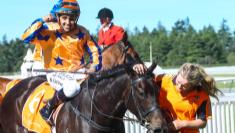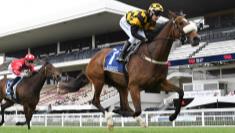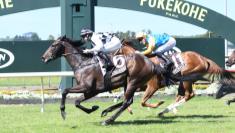
Early Haunui arrival doing well
Mother Nature works to its own timeframe and Haunui Farm was swiftly in sync to welcome an unexpected arrival this week and lavish the early comer with special treatment.
Breeding is an inexact science and the Karaka nursery was ahead of the game to be ready and waiting for the safe delivery of a healthy and happy daughter of young boom sire Almanzor.
The filly was the first of up to 150 to be foaled at the farm when she was born on Tuesday afternoon with mother Respect and daughter doing just fine.
“She is not that premature, which is good. She is bright and alert and she’s out of a Savabeel mare so she’s got a bit of x-factor about her and a little bit of attitude,” Haunui Managing Director Mark Chitty said.
“We look after the early ones because the weather is inclement and that’s probably the worst thing about an early born foal in New Zealand versus Australia.
“Our weather is probably worse in August and maybe early September at times, relative to the season, so we look after them at night and out they go if it’s a nice, fine day.”
The filly’s dam Respect, a private purchase for Haunui, boasts a strong international and Australasian pedigree that features the Gr.1 Newmarket Fillies’ Mile winner Lyric Of Light (1600m) and Australian Group winners Leebaz, Polish Knight, Zebrowski, Euro Angel and Mr Mozart among its ranks.
“The mare didn’t have a lot of milk to start with, but she has come to it quite quickly so it’s all good,” Chitty said.
“It was earlier than expected, I always go 11 months and 11 days, that’s about the average (pregnancy), so you shouldn’t really have any foals before about August 10 in essence, going from September 1.
“The mare’s last service date was September 4, so it is a bit early.”
In the Southern Hemisphere, the breeding season opens on September 1 and in the early 2000s a rule change deemed, regardless of their birth date, all foals turned yearlings on the following August 1.
“Our filly is not overtly premature, it has come early and I can remember moons ago we had a mare by Bigstone foal on July 27 and four days later the foal was a year old,” Chitty said.
“That was before the Stud Book changed and I think we’ve got a lot to be thankful for to Dr John Digby, who was the Keeper of the Australian Stud Book.
“He elected to change it relative to the date of mating so from September 1 any resulting progeny, even if a mare decided the foal was to come early, turned one on August 1.”
Early foals are traditionally keenly sought-after by buyers come yearling sale time, given they have longer to develop.
“There is no question about that and as New Zealanders we sell our yearlings toward the end of January,” Chitty said.
“In the Northern Hemisphere, a lot of them sell them in August, September and October and that’s another two or three months later than we do relative to the average date of birth.
“If you have an August or September foal here versus a November born foal, and there’s lot of November born foals, they are two to three months later and generally not as well physically developed, but beauty is in the eye of the beholder.
“There are some really good judges that can see what a horse is going to grow into and they take that opportunity and others don’t and only take the horse for what is sitting in front of them.”
Chitty said breeding practices had significantly changed during his time.
“When I first graduated as a veterinarian, we were still mating a lot of mares in late December and in and around Christmas and Boxing Day and that just doesn’t happen now.









